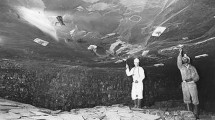Abstract
The Tapovan Vishnugad hydropower project (4 × 130 MW) in the Himalayan region of India, has been used as a case study to compare the problems and cost-effectiveness of a TBM or drill and blast excavation of the headrace tunnel and to assess the rock support measures for the powerhouse cavern. The NTH time and cost prognosis model indicated that the TBM would give a better weekly advance rate and unit excavation cost for the headrace tunnel. The Phase 2 finite element numerical modeling tool and the Hoek–Brown failure criterion were used to analyse the stresses and displacements likely to be experienced in the underground excavations. The rock support determined was compared with that indicated using the Q-method. The work has shown that numerical modeling can prove very useful in supplementing the results, provided the input parameters are accurate and take into account both direct measurements and judgment based on experience of the actual ground conditions.
Résumé
Le projet hydroélectrique de Tapovan Vishnugad (4 × 130 MW) dans la région himalayenne de l’Inde a été considéré comme étude de cas pour comparer les problèmes techniques et les coûts afférant à l’excavation au tunnelier, ou par des méthodes traditionnelles, de la galerie d’amenée et pour évaluer les dispositifs de confortement de l’usine hydroélectrique souterraine. Le « NTH time » et le modèle d’évaluation de coût ont indiqué que le tunnelier donnerait une cadence d’avancement à la semaine et un coût d’excavation légèrement meilleurs pour la galerie d’amenée. L’outil Phase de modélisation numérique par éléments finis et le critère de rupture de Hoek et Brown ont été utilisés pour analyser les contraintes et les déplacements attendus dans les excavations souterraines. Les renforcements mécaniques calculés ont été comparés avec ceux obtenus à partir de la méthode Q de Barton. Le travail a montré que la simulation numérique était très utile à condition que les paramètres d’entrée des modèles soient suffisamment précis et prennent en compte à la fois les mesures directes et le jugement d’expert quant aux conditions réelles de terrain.





Similar content being viewed by others
References
Bruland A Project Report 1B-98 Hard rock tunnel boring. Advance rate and cutter wear. Department of Building and Construction Engineering, NTNU, Norway
Bruland A Project Report 1C-98 Hard rock tunnel boring. Costs. Department of Building and Construction Engineering, NTNU, Norway
Bruland A Project Report 1D-98 hard rock tunnel boring. Geology and site investigation. Department of Building and Construction Engineering, NTNU, Norway
Chandra S (2008) Engineering geological analysis of Tapovan Vishnugad hydropower project in Himalayan region, India. M.Sc. thesis in hydropower development. Department of Geology and Mineral Resources Engineering, NTNU, Norway
Detailed Project Report, Tapovan—Vishnugadh HEP (Uttaranchal), India
Divatia E, Venkatesha CR, Binquet J, Colombet G (1993) Design of 10.6 km long headrace tunnel for Dul Hasti hydroelectric project (India). In: Burger H (ed) Options for tunneling 1993, developments in geotechnical engineering 74. Elsevier Science Publishers
Engineering Geology, Practical Use of the Q-Method, NGI Report (1997)
Goel RK (2004) Central Mining Research Insititute, India. Experiences of tunnelling in fragile Himalayan rocks, paper 3A 02, SINOROCK2004 symposium, Int J Rock Mech Min Sci, vol 41, no. 3, CD-ROM, ©2004 Elsevier Ltd
Goel RK, Jethwa JL, Paithankar AG (1995) Tunneling through the young Himalayas—a case history of the Maneri-Uttarkashi power tunnel. Eng Geol 39:31–44, Elsevier Science
Hoek E (2000) Practical rock engineering. Rockscience Inc. http://www.rockscience.com
Nilsen B, Alf T (1993) Rock engineering. Hydropower Development Series 9, NTNU
Nilsen B, Ozdemir L (1992) TBM projects and case histories in Norway. Proc annual technical conference of Institute of Shaft Drilling Technology (ISDT-92), Las Vegas, pp 4.15–4.33
Nilsen B, Palmström A (2000) Handbook no. 2, engineering geology and rock engineering. Norwegian Group for Rock Mechanics (NBG)
PHASE2 manual. http://www.rocscience.com/products/Phase2.asp
Project Report 2A-95. Tunneling blast design. Department of Building and Construction Engineering, NTNU, Norway
Project Report 2B-95. Tunneling prognosis for drill and blast. Department of Building and Construction Engineering, NTNU, Norway
Project Report 2C-95. Tunneling cost for drill and blast. Department of Building and Construction Engineering, NTNU, Norway
Acknowledgments
Contribution from Central Water Commission, New Delhi, India is acknowledged for kind consent of collecting the data and using the same for the academic purpose.
Author information
Authors and Affiliations
Corresponding author
Rights and permissions
About this article
Cite this article
Chandra, S., Nilsen, B. & Lu, M. Predicting excavation methods and rock support: a case study from the Himalayan region of India. Bull Eng Geol Environ 69, 257–266 (2010). https://doi.org/10.1007/s10064-009-0252-8
Received:
Accepted:
Published:
Issue Date:
DOI: https://doi.org/10.1007/s10064-009-0252-8




